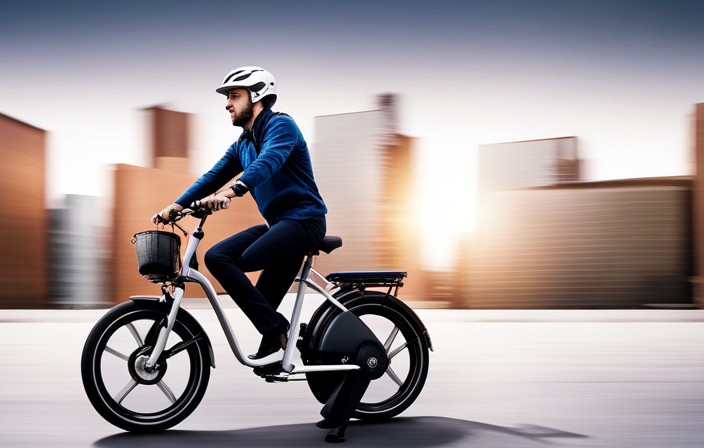As they say, knowledge is power, and when it comes to recharging your electric bike, that couldn’t be more true.
In this article, I’ll guide you through the process of recharging your electric bike’s battery with expert precision.
From understanding your battery type and capacity to finding the perfect charging station, I’ll provide you with the knowledge you need to keep your electric bike powered up and ready for your next adventure.
So let’s dive in and get recharging!
Key Takeaways
- Avoid overcharging the battery to reduce damage and extend battery life.
- Monitor the charging process and unplug when the battery is fully charged.
- Disconnect the charger properly to ensure battery longevity and safety.
- Store the battery in a cool, dry place and avoid extreme temperatures for optimal performance.
Understand Your Electric Bike’s Battery Type and Capacity
First, you need to understand your electric bike’s battery type and capacity. Battery maintenance is crucial for the optimal performance and longevity of your electric bike. Understanding battery technology is key to ensuring you get the most out of your battery.
Different electric bikes come with different types of batteries, such as lithium-ion or lead-acid. Each battery type has its own characteristics and requires specific care. It’s important to know the capacity of your battery, which is usually measured in watt-hours (Wh). This will help you determine how far you can ride on a single charge and plan your recharging accordingly.
By understanding your electric bike’s battery type and capacity, you can ensure proper care and make informed decisions about when to recharge your bike.
Now, let’s move on to determining the best time to recharge your electric bike.
Determine the Best Time to Recharge Your Electric Bike
To determine the best time for you to plug in your e-bike, consider your daily schedule and when you typically have downtime. Optimal charging frequency depends on factors such as battery capacity, usage patterns, and the type of charger. It is generally recommended to charge your e-bike battery after each ride to ensure it is ready for your next outing. However, if you have a larger battery capacity and shorter rides, you may be able to charge less frequently. It’s important to note that charging efficiency can be affected by factors such as temperature and charging speed. To help you visualize the charging frequency, here’s a table that outlines some common scenarios:
| Usage Pattern | Battery Capacity | Optimal Charging Frequency |
|---|---|---|
| Daily commute | Moderate (300Wh-400Wh) | Every night |
| Weekend recreational | High (400Wh-600Wh) | After each ride |
| Occasional use | Low (200Wh-300Wh) | Every few days |
| Long-distance touring | Extra high (>600Wh) | After each day of riding |
Now that you know the optimal charging frequency, let’s move on to locating a suitable charging station or outlet.
Locate a Suitable Charging Station or Outlet
When looking for a place to charge your e-bike, you’ll want to find a suitable charging station or outlet nearby. Electric bike charging station availability can vary depending on your location, but with the increasing popularity of e-bikes, more charging options are becoming available.
To ensure that you can find charging solutions for long distance rides, it’s important to plan ahead and research charging stations along your route. Many cities now have dedicated charging stations specifically for electric bikes, which can be found using various online maps and apps. Additionally, some businesses and public places may offer outlets that you can use to charge your e-bike while you take a break.
By knowing where to find these charging options, you can confidently embark on long rides without worrying about running out of battery power.
Now, let’s move on to the next step: connecting your electric bike’s battery to the charger.
Connect Your Electric Bike’s Battery to the Charger
Once you’ve located a suitable charging station or outlet nearby, it’s time to connect your e-bike’s battery to the charger. Understanding charger compatibility is important to ensure a successful charging process. Make sure that the charger you are using is compatible with your e-bike’s battery voltage and connector type. Refer to the manufacturer’s instructions for specific details. To connect the battery to the charger, locate the charging port on your e-bike, usually found near the rear wheel or on the underside of the frame. Then, plug the charger into the charging port and ensure it is securely connected.
| Charger Compatibility | Troubleshooting Charging Issues |
|---|---|
| Check battery voltage | Inspect charger cable |
| Verify connector type | Check power source |
| Review manufacturer’s instructions | Allow battery to cool down if needed |
| Contact customer support if issues persist |
Now that your e-bike’s battery is connected to the charger, you can monitor the charging progress and time.
Monitor the Charging Progress and Time
Keep an eye on the charging progress and time to ensure that your battery is being charged properly. Monitoring techniques and charging time optimization are crucial for maintaining the health and longevity of your electric bike’s battery. Here are three important things to consider:
-
Use a smart charger: Investing in a smart charger allows you to monitor the charging progress, ensuring that the battery is not overcharged or undercharged. These chargers typically come with built-in safety features that protect the battery from any potential damage.
-
Track charging time: It is essential to keep track of the time it takes for your electric bike’s battery to fully charge. This will help you optimize your charging routine and avoid unnecessary overcharging, which can degrade the battery’s performance over time.
-
Follow manufacturer’s guidelines: Each electric bike’s battery has specific charging requirements. It is important to follow the manufacturer’s guidelines regarding charging voltage, current, and duration. This will ensure that you are charging your battery correctly and maximizing its lifespan.
Avoid Overcharging Your Electric Bike’s Battery
To prevent overcharging, make sure you follow the manufacturer’s guidelines for charging your battery correctly. Overcharging your electric bike’s battery can not only shorten its lifespan but can also be a safety hazard. By avoiding overcharging, you can prolong the battery life and ensure optimal performance. Here are some key tips to avoid overcharging:
| 1. Use the right charger | Check that the charger you are using is specifically designed for your electric bike’s battery. Using the wrong charger can lead to overcharging. |
| 2. Set a timer | Set a timer or use a charger with an automatic shut-off feature to prevent overcharging. This way, the charger will stop supplying power once the battery is fully charged. |
| 3. Monitor the charging progress | Keep an eye on the charging progress and unplug the charger once the battery reaches its recommended charge level. |
| 4. Avoid leaving the battery charging overnight | Leaving the battery charging for an extended period can lead to overcharging and damage the battery. |
| 5. Follow the manufacturer’s recommendations | Always refer to the manufacturer’s guidelines for specific charging instructions and recommendations. |
Safely Disconnect the Charger from the Battery
Make sure you unplug the charger from the battery safely to avoid any potential hazards.
When it comes to handling electric bike batteries, there are a few tips to keep in mind. One of the most common charging mistakes to avoid is leaving the charger plugged in for too long. Overcharging can lead to reduced battery life and even damage. To prevent this, always monitor the charging process and unplug the charger once the battery is fully charged.
Additionally, be careful not to yank or pull the charger out forcefully, as this can damage the connector or the battery itself. Taking the time to disconnect the charger properly will help ensure the longevity and safety of your electric bike’s battery.
Speaking of battery longevity, let’s move on to the next section on how to store your electric bike’s battery properly.
Store Your Electric Bike’s Battery Properly
When storing your battery, make sure you store it in a cool and dry place to protect its longevity. Proper battery storage is crucial for extending battery lifespan and ensuring optimal performance. Here are three key points to consider when storing your electric bike’s battery:
-
Temperature control: Extreme temperatures can negatively affect battery performance. Avoid storing your battery in locations that are too hot or too cold, as this can lead to reduced capacity and overall degradation.
-
Moisture prevention: Moisture can cause corrosion and damage to the battery. Keep your battery in a dry environment to prevent any moisture from seeping in and compromising its functionality.
-
Avoid direct sunlight: Prolonged exposure to direct sunlight can cause overheating and damage to the battery. Store it in a shaded area or cover it with a cloth or towel to protect it from the sun’s rays.
Maximize Battery Life with Regular Maintenance
Regular maintenance is key to ensuring your battery lasts as long as possible. By taking care of your electric bike’s battery, you can maximize its lifespan and get the most out of your rides. Here are some important maintenance tasks to keep in mind:
| Maintenance Task | Frequency |
|---|---|
| Clean the battery contacts | Every month |
| Check for damage or wear | Every ride |
| Store the battery properly | When not in use |
| Avoid extreme temperatures | Always |
Cleaning the battery contacts regularly helps to maintain a good connection and prevent corrosion. Checking for any damage or wear ensures that you catch any issues early on. Storing the battery properly when not in use, such as in a cool and dry place, can extend its lifespan. Additionally, avoiding extreme temperatures can help protect the battery from unnecessary stress.
Tips for Recharging Your Electric Bike on the Go
Now that we’ve covered the importance of regular maintenance for maximizing the battery life of your electric bike, let’s discuss some tips for recharging your bike on the go.
One convenient option is using a portable charger specifically designed for electric bikes. This compact device allows you to recharge your bike’s battery wherever you are, without the need for a traditional power outlet. The benefits of using a portable charger include:
- Portability: Easily carry the charger with you in your backpack or bike bag.
- Versatility: Compatible with various electric bike models and battery types.
To further extend the battery life of your electric bike, consider these tips:
- Use pedal assist mode when possible to minimize strain on the battery.
- Keep the battery charged between 20-80% for optimal performance.
Frequently Asked Questions
How long does it typically take to fully recharge an electric bike’s battery?
Typically, it takes around 4-6 hours to fully recharge an electric bike’s battery. To extend the battery life, avoid overcharging and keep it at a moderate temperature. For faster charging, use a high-quality charger and avoid using the bike while it’s charging.
Can I use any type of charging cable or adapter to connect my electric bike’s battery to the charger?
Using an incompatible charging cable for your electric bike’s battery is like trying to fit a square peg into a round hole—it just won’t work. It can lead to potential risks, such as damage to the battery or even fire hazards.
Is it safe to leave my electric bike’s battery connected to the charger overnight?
Leaving electric bike batteries connected to the charger overnight can pose potential risks such as overcharging and overheating. Alternatives to overnight charging include charging during the day or using a timer to ensure a safe and efficient charging process.
How often should I recharge my electric bike’s battery to maintain optimal performance?
To maintain optimal performance, I recharge my electric bike’s battery every 2-3 days. This recharge frequency ensures that the battery remains at its peak level, allowing me to enjoy a smooth and efficient ride every time.
Are there any specific maintenance tasks I need to perform on my electric bike’s battery to ensure its longevity?
To ensure the longevity of my electric bike’s battery, I perform regular battery maintenance tasks. This includes using proper battery charging techniques, such as avoiding overcharging or fully draining the battery, and keeping it clean and dry.
Conclusion
In conclusion, recharging my electric bike has become an integral part of my routine. Understanding the battery type and capacity, finding the right charging station, and monitoring the progress have all contributed to maximizing its performance.
It’s amazing how coincidences can make life easier, and coincidentally, recharging my bike has brought me a sense of freedom and convenience. With regular maintenance and proper storage, I can confidently say that my electric bike will continue to serve me well on my adventures.
So, let’s embrace the power of electric bikes and recharge on the go!









